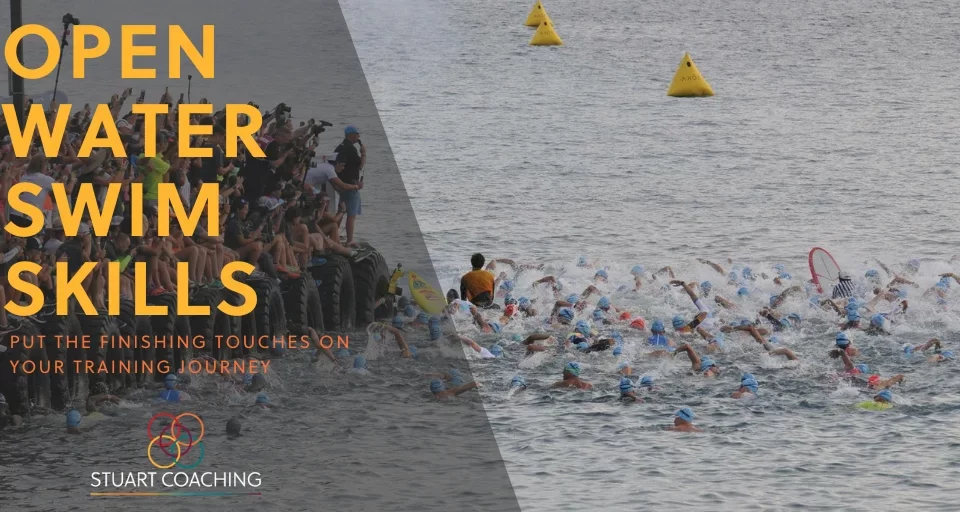
Race Week: Put the Finishing Touches on your Training
September 14, 2023
IRONMAN Florida 70.3 2023 Race Recap
December 15, 2023Triathlon presents athletes with a fair share of obstacles including navigating cold water. Recently, several Stuart Coaching athletes raced the IRONMAN Michigan 70.3, where Betsie Bay’s chilly waters greeted them at 61 degrees! Man, do I hate cold water, but they were rockstars, stayed calm and all had a great day. In preparation for this unexpected challenge, we implemented some last-minute strategies that proved instrumental in helping them endure the chilly water. In this post, I’ll give you the tips I shared with my athletes and also delve into the specific risks associated with cold water swimming.
Understanding the Risks:
Before diving in, it’s crucial to be aware of the potential risks of cold water swimming:
- Hypothermia: Exposure to cold water for an extended period can lead to a drop in body temperature, resulting in hypothermia. Symptoms include shivering, numbness, confusion, and, in severe cases, loss of consciousness.
- Cold Water Shock: The sudden immersion in cold water can cause an involuntary gasp reflex, which can lead to drowning if you’re not prepared.
- Cold Water Immersion Syndrome: Cold water can cause blood vessels to constrict, increasing the strain on the heart and potentially leading to a heart attack, especially in individuals with pre-existing heart conditions.
- Swimming-induced Pulmonary Edema (SIPE): SIPE is the leading cause of triathlon-related swim emergencies and death in healthy individuals. It is a form of pulmonary edema , which in layman’s terms is fluid and blood in the lungs, caused by increased internal pressure. Cold water and wetsuit compression are two factors that can increase risk.
Steps to Prepare:
Now that you’re aware of the risks, let’s look at the steps to prepare for cold water swimming:
Acclimatization:
If you are anticipating that your triathlon swim may be cold, make sure to gradually acclimate your body to colder temperatures by practicing cold water swimming. This helps your body adapt to the shock of cold water and prevent hyperventilation or panic. If weeks of cold water acclimatization is not an option, try some cold showers! And, at least make sure to take a dip in the cold water the day before race day so you can anticipate how it will feel.
Proper Gear:
Invest in high-quality cold water swimming gear to provide insulation and help maintain your body temperature. Make sure to check with the rules for your event on what items are allowed. Click the item below to link to my recommendations on Amazon.
-
- Full Sleeve Wetsuit – core body heat is lost through the armpits on a sleeveless wetsuit
- Neoprene Swim Cap – you can double up on swim caps too. Lots of heat is lost through the head.
- Neoprene Swim Booties or Socks
- Swim gloves – you’ll want to make sure that this is allowed by the event organizers
- Ear plugs
- Vasoline– this can protect any exposed skin, make sure to put it on after your goggles!
Swim with a Buddy:
Never swim in cold water alone. Always have a swimming buddy or lifeguard present to assist in case of an emergency. Make sure you use a swim buoy.
Warm-Up Exercises:
Before entering the swim (whether it’s cold or warm), perform warm-up exercises to increase blood circulation and prepare your muscles for the swim. Whether to do a pre-race swim will depend on the air temperature and the amount of time between the practice time and race start. While a 10-15 minute swim warm-up can be very helpful to minimize shock, it also can be very unpleasant to then have to stand in the cold air for 45 minutes before the swim start – so use your own discretion on the swim warm up.
Controlled Entry:
Enter the water slowly to allow your body time to adjust to the temperature and to minimize the shock response. When the cold water hits your face, your immediate reaction will be to gasp and it will be difficult to find your breathing rhythm. So don’t jump right in! Take time to put your face in the water and when you do start swimming, start slow, and anticipate that the cold water will affect your breathing initially. If you stay calm, you will eventually warm up and find your rhythm.
Know When to Stop:
Pay close attention to your body. If you experience deep shivering, numbness, find yourself coughing or see blood or blood colored spit, it’s time to exit the water immediately. Remember, everyone experiences cold water differently. So, you must trust your own intuition and prioritize your own safety. There will be more races.
By following these steps and prioritizing safety, you can make the most of your cold water swimming experience while minimizing the associated risks. Remember, preparation and awareness are key to mastering the chill and (dare I say) enjoying the adventure of swimming in cold waters.
As an Amazon Associate I earn from qualifying purchases.

